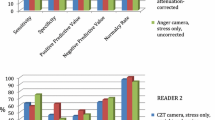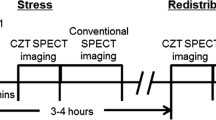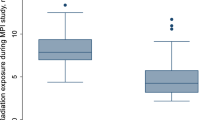Abstract
Purpose
The results of stress myocardial perfusion SPECT could be enhanced by new cadmium-zinc-telluride (CZT) cameras, although differences compared to the results with conventional Anger cameras remain poorly known for most study protocols. This study was aimed at comparing the results of CZT and Anger SPECT according to various study protocols while taking into account the influence of obesity.
Methods
The study population, which was from three different institutions equipped with identical CZT cameras, comprised 276 patients referred for study using protocols involving 201Tl (n = 120) or 99mTc-sestamibi injected at low dose at stress (99mTc-Low; stress/rest 1-day protocol; n = 110) or at high dose at stress (99mTc-High; rest/stress 1-day or 2-day protocol; n = 46). Each Anger SPECT scan was followed by a high-speed CZT SPECT scan (2 to 4 min).
Results
Agreement rates between CZT and Anger SPECT were good irrespective of the study protocol (for abnormal SPECT, 201Tl 92 %, 99mTc-Low 86 %, 99mTc-High 98 %), although quality scores were much higher for CZT SPECT with all study protocols. Overall correlations were high for the extent of myocardial infarction (r = 0.80) and a little lower for ischaemic areas (r = 0.72), the latter being larger on Anger SPECT (p < 0.001). This larger extent was mainly observed in 50 obese patients who were in the 201Tl or 99mTc-Low group and in whom stress myocardial counts were particularly low with Anger SPECT (228 ± 101 kcounts) and dramatically enhanced with CZT SPECT (+279 ± 251 %).
Conclusion
Concordance between the results of CZT and Anger SPECT is good regardless of study protocol and especially when excluding obese patients who have low-count Anger SPECT and for whom myocardial counts are dramatically enhanced on CZT SPECT.





Similar content being viewed by others
References
Slomka PJ, Patton JA, Berman DS, Germano G. Advances in technical aspects of myocardial perfusion SPECT imaging. J Nucl Cardiol. 2009;16(2):255–76.
Schillaci O, Danieli R. Dedicated cardiac cameras: a new option for nuclear myocardial perfusion imaging. Eur J Nucl Med Mol Imaging. 2010;37(9):1706–9.
Mouden M, Timmer JR, Ottervanger JP, Reiffers S, Oostdijk AH, Knollema S, et al. Impact of a new ultrafast CZT SPECT camera for myocardial perfusion imaging: fewer equivocal results and lower radiation dose. Eur J Nucl Med Mol Imaging. 2012;39(6):1048–55.
Duvall WL, Croft LB, Ginsberg ES, Einstein AJ, Guma KA, George T, et al. Reduced isotope dose and imaging time with a high-efficiency CZT SPECT camera. J Nucl Cardiol. 2011;18(5):847–57.
Gimelli A, Bottai M, Giorgetti A, Genovesi D, Filidei E, Marzullo P. Evaluation of ischaemia in obese patients: feasibility and accuracy of a low-dose protocol with a cadmium-zinc telluride camera. Eur J Nucl Med Mol Imaging. 2012;39(8):1254–61.
Gimelli A, Bottai M, Genovesi D, Giorgetti A, Di Martino F, Marzullo P. High diagnostic accuracy of low-dose gated-SPECT with solid-state ultrafast detectors: preliminary clinical results. Eur J Nucl Med Mol Imaging. 2012;39(1):83–90.
Thorley PJ, Chowdhury FU. Low incidence of attenuation artefacts in women on myocardial perfusion imaging using a discovery 530c solid state cardiac gamma camera. Eur J Nucl Med Mol Imaging. 2011;38:s305 (abstract).
Erlandsson K, Kacperski K, Van Gramberg D, Hutton BF. Performance evaluation of D-SPECT: a novel SPECT system for nuclear cardiology. Phys Med Biol. 2009;54(9):2635–49.
Gambhir SS, Berman DS, Ziffer J, Nagler M, Sandler M, Patton J, et al. A novel high-sensitivity rapid-acquisition single-photon cardiac imaging camera. J Nucl Med. 2009;50(4):635–43.
Sharir T, Ben-Haim S, Merzon K, Prochorov V, Dickman D, Ben-Haim S, et al. High-speed myocardial perfusion imaging initial clinical comparison with conventional dual detector anger camera imaging. JACC Cardiovasc Imaging. 2008;1(2):156–63.
Sharir T, Slomka PJ, Hayes SW, DiCarli MF, Ziffer JA, Martin WH, et al. Multicenter trial of high-speed versus conventional single-photon emission computed tomography imaging: quantitative results of myocardial perfusion and left ventricular function. J Am Coll Cardiol. 2010;55(18):1965–74.
Kapur A, Latus KA, Davies G, Dhawan RT, Eastick S, Jarritt PH, et al. A comparison of three radionuclide myocardial perfusion tracers in clinical practice: the ROBUST study. Eur J Nucl Med Mol Imaging. 2002;29(12):1608–16.
Robinson CN, van Aswegen A, Julious SA, Nunan TO, Thomson WH, Tindale WB, et al. The relationship between administered radiopharmaceutical activity in myocardial perfusion scintigraphy and imaging outcome. Eur J Nucl Med Mol Imaging. 2008;35(2):329–35.
Freedman N, Schechter D, Klein M, Marciano R, Rozenman Y, Chisin R. SPECT attenuation artifacts in normal and overweight persons: insights from a retrospective comparison of Rb-82 positron emission tomography and TI-201 SPECT myocardial perfusion imaging. Clin Nucl Med. 2000;25(12):1019–23.
Hansen CL, Woodhouse S, Kramer M. Effect of patient obesity on the accuracy of thallium-201 myocardial perfusion imaging. Am J Cardiol. 2000;85(6):749–52.
Thompson RC, Heller GV, Johnson LL, Case JA, Cullom SJ, Garcia EV, et al. Value of attenuation correction on ECG-gated SPECT myocardial perfusion imaging related to body mass index. J Nucl Cardiol. 2005;12(2):195–202.
Notghi A, Williams N, Smith N, Goyle S, Harding LK. Relationship between myocardial counts and patient weight: adjusting the injected activity in myocardial perfusion scans. Nucl Med Commun. 2003;24(1):55–9.
Manrique A, Marie PY. Recommendations for the performance and interpretation of myocardial perfusion tomoscintigraphy. Arch Mal Coeur Vaiss. 2003;96(6):695–711.
Marie PY, Djaballah W, Franken PR, Vanhove C, Muller MA, Boutley H, et al. OSEM reconstruction, associated with temporal fourier and depth-dependant resolution recovery filtering, enhances results from sestamibi and 201Tl 16-interval gated SPECT. J Nucl Med. 2005;46(11):1789–95.
Cerqueira MD, Weissman NJ, Dilsizian V, Jacobs AK, Kaul S, Laskey WK, et al. Standardized myocardial segmentation and nomenclature for tomographic imaging of the heart: a statement for healthcare professionals from the Cardiac Imaging Committee of the Council on Clinical Cardiology of the American Heart Association. Circulation. 2002;105:539–42.
Marie PY, Mercennier C, Danchin N, Djaballah K, Gretzinger A, Zannad F, et al. Residual exercise-SPECT ischemia on treatment is a main determinant of outcome in patients with coronary artery disease treated medically at long-term by beta-blockers. J Nucl Cardiol. 2003;10:361–8.
Marie PY, Danchin N, Branly F, Angioi M, Grentzinger A, Virion JM, et al. Effects of medical therapy on outcome assessment using exercise thallium-201 single photon emission computed tomography imaging: evidence of a protective effect of beta-blocking antianginal medications. J Am Coll Cardiol. 1999;34(1):113–21.
Hesse B, Tagil K, Cuocolo A, Anagnostopoulos C, Bardies M, Bax J, et al. EANM/ESC procedural guidelines for myocardial perfusion imaging in nuclear cardiology. Eur J Nucl Med Mol Imaging. 2005;32:855–97.
Nakazato R, Tamarappoo BK, Kang X, Wolak A, Kite F, Hayes SW, et al. Quantitative upright–supine high-speed SPECT myocardial perfusion imaging for detection of coronary artery disease: correlation with invasive coronary angiography. J Nucl Med. 2010;51(11):1724–31.
Fiechter M, Ghadri JR, Kuest SM, Pazhenkottil AP, Wolfrum M, Nkoulou RN, et al. Nuclear myocardial perfusion imaging with a novel cadmium-zinc-telluride detector SPECT/CT device: first validation versus invasive coronary angiography. Eur J Nucl Med Mol Imaging. 2011;38(11):2025–30.
Duvall WL, Sweeny JM, Croft LB, Barghash MH, Kulkarni NK, Guma KA, et al. Comparison of high efficiency CZT SPECT MPI to coronary angiography. J Nucl Cardiol. 2011;18(4):595–604.
Buechel RR, Herzog BA, Husmann L, Burger IA, Pazhenkottil AP, Treyer V, et al. Ultrafast nuclear myocardial perfusion imaging on a new gamma camera with semiconductor detector technique: first clinical validation. Eur J Nucl Med Mol Imaging. 2010;37(4):773–8.
Ayalew A, Marie PY, Menu P, Mertes PM, Hassan N, Danchin N, et al. A comparison of the overall first-pass kinetics of thallium-201 and technetium-99m MIBI in normoxic and low-flow ischaemic myocardium. Eur J Nucl Med. 2000;27(11):1632–40.
Ayalew A, Marie PY, Menu P, Mertes PM, Audonnet S, Jouan V, et al. (201)Tl and (99 m)Tc-MIBI retention in an isolated heart model of low-flow ischemia and stunning: evidence of negligible impact of myocyte metabolism on tracer kinetics. J Nucl Med. 2002;43(4):566–74.
Bateman TM, Heller GV, McGhie AI, Friedman JD, Case JA, Bryngelson JR, et al. Diagnostic accuracy of rest/stress ECG-gated Rb-82 myocardial perfusion PET: comparison with ECG-gated Tc-99m sestamibi SPECT. J Nucl Cardiol. 2006;13(1):24–33.
Herzog BA, Buechel RR, Husmann L, Pazhenkottil AP, Burger IA, Wolfrum M, et al. Validation of CT attenuation correction for high-speed myocardial perfusion imaging using a novel cadmium-zinc-telluride detector technique. J Nucl Med. 2010;51(10):1539–44.
Acknowledgments
The authors thank: Henri Boutley for his help in image analysis, Pierre Pothier for critical review of the manuscript and Nancy University Hospital for financial and organizational support.
Author information
Authors and Affiliations
Corresponding author
Rights and permissions
About this article
Cite this article
Verger, A., Djaballah, W., Fourquet, N. et al. Comparison between stress myocardial perfusion SPECT recorded with cadmium-zinc-telluride and Anger cameras in various study protocols. Eur J Nucl Med Mol Imaging 40, 331–340 (2013). https://doi.org/10.1007/s00259-012-2292-8
Received:
Accepted:
Published:
Issue Date:
DOI: https://doi.org/10.1007/s00259-012-2292-8




